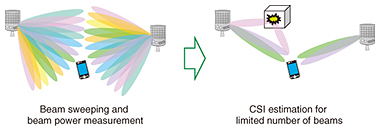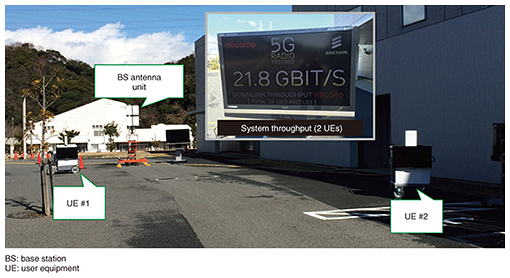 |
|||||||||||||||||
|
|
|||||||||||||||||
|
Feature Articles: Wireless Access Technology to Meet Diverse Needs from IoT/M2M to Broadband Vol. 15, No. 3, pp. 6–12, Mar. 2017. https://doi.org/10.53829/ntr201703fa2 Standardization Status towards the Introduction of 5G in 2020AbstractThere is growing interest worldwide in the introduction of fifth-generation mobile communications systems (5G) by 2020 or earlier, and extensive efforts on 5G field experiments are being vigorously carried out in many countries and regions. 3GPP (3rd Generation Partnership Project), the standards organization for mobile communications systems, held the RAN (radio access network) Workshop on 5G in September 2015. Subsequently, discussions started on the standardization of new radio interfaces for 5G. This article outlines the approaches and the current status of standardization towards the introduction of 5G in 2020. Keywords: 5G standardization, New RAT, wireless access 1. Introduction: Phased approach of 5G standardizationWireless communications services in the era of fifth-generation mobile communications systems (5G) can be characterized by two major trends. One is enhanced mobile broadband (eMBB), which provides extreme broadband data transfer, and the other is Internet of Things (IoT), which connects everything to wireless networks. To achieve the services depicted in Fig. 1, two approaches for technical advancement are being considered: enhanced Long Term Evolution (eLTE), which denotes the continued evolution of 4G (LTE, LTE-Advanced, LTE-Advanced Pro), and New Radio Access Technology (New RAT), the introduction of the new 5G radio interface specification.
The former is an evolutionary approach that emphasizes backward compatibility with existing 4G systems. The latter is a clean slate approach to drastically improve performance; it emphasizes ultimate performance over backward compatibility. It is expected that 5G will be realized by some combination of eLTE and New RAT [1, 2]. A possible 5G deployment scenario that uses the NTT DOCOMO assumption about the combination of eLTE and New RAT is illustrated in Fig. 2. In the early stage of 5G deployment in 2020, eLTE and New RAT will be introduced in areas that require large capacity such as dense urban centers. Dual connectivity technology [1], which separates control and user data planes, will be used to enable cooperation between eLTE and New RAT to support sufficient coverage and mobility, while achieving high-speed and large-capacity mobile communications environments. In later stages, 5G will gradually be expanded from large cities to suburban and rural areas, under the assumption that new frequency bands such as millimeter wave bands, which are not used for current mobile communications, will be deployed as necessary.
To achieve the deployment of New RAT in 2020, the initial version of the specifications should be completed by mid-2018 at the latest. The standardization work therefore has to progress in accordance with the rather tight schedule. However, the International Telecommunications Union - Radiocommunications Sector (ITU-R), the organization that recommends international radio standards, wants the final interface specifications for supporting 5G (IMT-2020) to be completed by the end of 2019, allowing room for additional improvement of specifications. Accordingly, the consensus is to take the phased approach in 5G standardization for New RAT while incorporating the vision of achieving the early introduction of 5G as well as its subsequent evolution. In the phased approach, the initial specification (Phase 1) of New RAT has to be completed within a limited period of time. It is therefore important to establish the base design with an emphasis on forward compatibility instead of incorporating many new features. Specifically, it is realistic to design New RAT with a limited scope that focuses on the basic performance of eMBB to support 5G attributes such as high speed, large capacity, and low latency (Fig. 3). To augment wide area coverage, 4G and eLTE will continue to be used to support IoT services, which must connect many M2M (machine-to-machine) devices at low cost. In later stages, the final New RAT specification (Phase 2 and later) will include many new features and will be introduced gradually to support new unknown services in the era of 5G and IoT.
2. Standardization status of New RATStandardization is proceeding on various components and technologies associated with New RAT. We report here on the latest standardization efforts. 2.1 Frequency bandsFor 5G, the use of extremely wide frequency bands is being considered; they range from legacy low frequency bands to higher frequency bands, including millimeter wave, up to the maximum of 100 GHz. However, the frequency bands that will be available for commercial deployment in 2020, the target of Phase 1 specification, will be limited. During the RAN Workshop on 5G held by the 3rd Generation Partnership Project (3GPP) in September 2015, a discussion was held on whether to support frequency bands above 6 GHz, considering the strategies of operators and the usage of frequency bands in individual countries. While each operator and each country targeted different target frequency bands for 5G, the Federal Communications Commission (FCC) in the United States announced the allocation of frequency bands above 24 GHz to 5G [3]. The logic of supporting higher frequency bands (up to 50 GHz) in Phase 1 is gradually being accepted by the market. Thus in 3GPP, it was agreed that the scope of wireless technology in the Phase 1 specification (Release 15) should include frequencies both below and above 6 GHz [4]. 2.2 Optimization for IoT-related servicesAnother topic of discussion in 3GPP concerns what features to include in the Phase 1 specification for optimization in terms of IoT-related services, for example, massive machine type communications (mMTC) and ultra-reliable and low latency communications (URLLC). Many opinions were exchanged during the 3GPP workshop. For example, some participants thought that Phase 1 should focus on eMBB and that the specification should consider eMBB, mMTC, and URLLC equally. Later, a number of companies cooperatively proposed that 3GPP complete the Phase 1 Work Items early, and as a result of extensive discussions, it was agreed that the Phase 1 specification would include eMBB and part of URLLC only in order to complete standardization early. However, the basic study according to the current Study Item includes the features for IoT as well as eMBB, and work is still in progress. Such features include channel coding schemes for small packets, and non-orthogonal multiple access schemes. 2.3 Support of standalone operationThe previous section mentioned NTT DOCOMO’s assumption as to the combination of eLTE and New RAT for a deployment scenario. The dual connectivity technology enables MeNB (master evolved NodeB) to be used to provide the control plane function of eLTE and SeNB (secondary evolved NodeB) to be used only to provide the user plane function of New RAT. In this arrangement, New RAT can operate only within eLTE coverage, which is referred to as non-standalone operation. The benefit of this arrangement is that the specification of New RAT can be simplified since it does not need to provide the functions needed for standalone operation. Those functions include the support of broadcast information and an idle mode. A proposal was made for early completion of the Phase 1 Work Items, and based on that, an agreement was reached on the overall work plan to complete the Phase 1 physical layer specification for non-standalone operation by the end of 2017, three months earlier than the original plan [4]. 2.4 Standardization scheduleAn illustration of our assumed standardization schedule is shown in Fig. 4. The overall direction has been publicized in line with the phased approach agreed on in the 3GPP workshop. The core part of Phase 1 specifications will be completed by September 2018, and the core part of Phase 2 specifications, which satisfy the requirements of ITU-R, will be completed by December 2019 [5]. Furthermore, it was agreed that the Phase 1 physical layer specifications for non-standalone operation are to be completed by the end of 2017 [4].
3. Current status of New RAT studyThe standardization of New RAT has been progressing in 3GPP, and research and development (R&D) of 5G radio technologies is underway as part of many national projects and by operators and equipment vendors worldwide. This section introduces two wireless technologies for New RAT: basic radio parameters with frame structures, and multi-antenna transmission technology. Standardization efforts and trials are also described. 3.1 Radio parameters with frame structuresTo support a wide range of frequency bands and use cases for 5G, it is necessary to support multiple different numerologies, which are defined sets of radio parameters such as sub-carrier spacing and TTI (Transmission Time Interval). One effective approach is to design variable parameters based on the numerology of legacy LTE [1]. Of particular interest are the higher frequency bands targeted for 5G, which allow broader sub-carrier spacing than that possible with LTE. In the current study underway in 3GPP, the working assumptions to define scalable numerology based on LTE are as follows.
To realize the dynamic time division duplex (TDD) scheme, which can dynamically switch between uplink and downlink within the same carrier, the self-contained subframe that suits low latency retransmission control is being studied in order to overcome the issues posed by the quasi-fixed TDD scheme. A number of approaches have been discussed (Fig. 5). These include permanently allocating the head of a subframe to the downlink control signal and the tail of the subframe to that of the uplink, and allocating the middle of the subframe to the data signal of both downlink and uplink, as well as to other reference signals.
3.2 Multi-antenna transmission technologyOne of the key technologies enabling 5G to achieve drastic increases in capacity is massive multiple input multiple output (MIMO). It improves frequency usage efficiency through spatial multiplexing, and its beamforming gain helps to compensate for the propagation loss in higher frequency bands. The key issue in radio interface design is to efficiently support beam search, beam tracking, and diversity control of spatial multiplexing by controlling massive numbers of antenna devices with limited reference signals and low control overhead. Technical solutions have been proposed in order to address this issue, including the use of multiple hierarchical reference signals and beam control schemes suitable for analog-digital hybrid beamforming [6, 7]. The 5G experiment [8] conducted by NTT DOCOMO and Ericsson demonstrated highly efficient beam control by using multiple types of reference signals such as beam synchronization signals, a mobility reference signal (MRS) to measure the power of each beam, and a channel state information reference signal (CSI-RS) to measure channel quality for MIMO multiplexing (Fig. 6). First, a base station transmits synchronization signals and an MRS while rotating its beam direction, and a terminal receives those signals to establish synchronization and measures the MRS received power (MRSRP). The base station receives feedback from the terminal on MRSRP, selects the effective beam candidates for the terminal, and transmits the CSI-RS. The terminal receives the CSI-RS and derives the channel matrix to select the optimum combination of beams to maximize its throughput and to control the rank of MIMO multiplexing. This beam control scheme can be extended for multi-user MIMO and multipoint transmission. The 5G field experiment in the 15-GHz band conducted by NTT DOCOMO and Ericsson achieved an aggregated throughput of more than 20 Gbit/s by allocating four beams to two users at the same time in the frequency band of 800 MHz in an outdoor environment (Fig. 7).
4. ConclusionIn this article, the current status of 5G standardization was described together with the latest developments achieved in field trials. All the efforts mentioned herein are expected to provide a new area of services such as eMBB to provide high-speed and large-capacity broadband access, and IoT to connect everything to networks. NTT DOCOMO will continue to carry out advanced R&D and to contribute to standardization activities with the aim of achieving the initial deployment of 5G services in 2020, and the continued evolution of 5G (5G+) in later years. References
|
|||||||||||||||||


















